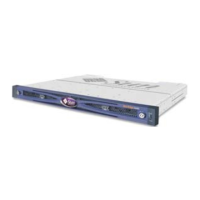6-12 Sun StorEdge 3000 Family Installation, Operation, and Service Manual • May 2004
Note – Your array is preconfigured with Sequential Optimization. If Random
Optimization is more appropriate for your use, you need to delete all of the
preconfigured logical drives, change the optimization mode, reboot the array, and
then create new logical drives.
The type of application accessing the array determines whether random or
sequential I/O should be applied. Video and imaging application’s I/O size can be
128, 256, 512 Kilobyte, or up to 1 Mbyte, so the application reads and writes data to
and from the drive as large-block, sequential files. Database and transaction-
processing applications read and write data from the drive as small-block, randomly
accessed files.
There are two limitations that apply to the optimization modes:
■ One optimization mode must be applied to all logical drives in an array.
■ Once the optimization mode is selected and data written to logical drives, the
only way to change the optimization mode is to back up all data to another
location, delete all logical drives, reconfigure the array with the new optimization
mode, and reboot the array. Then you can create new logical drives.
Note – The maximum allowable size of a logical drive optimized for sequential I/O
is 2 Tbyte. The maximum allowable size of a logical drive optimized for random I/O
is 512 Gbyte. When creating a logical drive that exceeds these limits, an error
message is displayed.
For more information about optimization modes, refer to the Sun StorEdge 3000
Family RAID Firmware User’s Guide for your array.
6.1.7 Maximum Number of Disks and Maximum
Usable Capacity for Random and Sequential
Optimization
Your choice of random or sequential optimization affects the maximum number of
disks you can include in a logical drive and the maximum usable capacity of a
logical drive.

